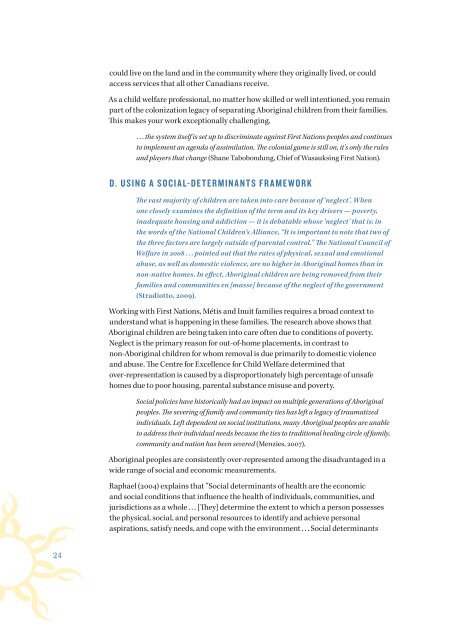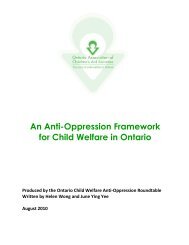English - Ontario Association of Children's Aid Societies
English - Ontario Association of Children's Aid Societies
English - Ontario Association of Children's Aid Societies
Create successful ePaper yourself
Turn your PDF publications into a flip-book with our unique Google optimized e-Paper software.
could live on the land and in the community where they originally lived, or could<br />
access services that all other Canadians receive.<br />
As a child welfare pr<strong>of</strong>essional, no matter how skilled or well intentioned, you remain<br />
part <strong>of</strong> the colonization legacy <strong>of</strong> separating Aboriginal children from their families.<br />
This makes your work exceptionally challenging.<br />
. . . the system itself is set up to discriminate against First Nations peoples and continues<br />
to implement an agenda <strong>of</strong> assimilation. The colonial game is still on, it’s only the rules<br />
and players that change (Shane Tabobondung, Chief <strong>of</strong> Wasauksing First Nation).<br />
D. USING A SOCIAL-DETERMINANTS FRAMEWORK<br />
The vast majority <strong>of</strong> children are taken into care because <strong>of</strong> ‘neglect’. When<br />
one closely examines the definition <strong>of</strong> the term and its key drivers — poverty,<br />
inadequate housing and addiction — it is debatable whose ‘neglect’ that is: in<br />
the words <strong>of</strong> the National Children’s Alliance, “It is important to note that two <strong>of</strong><br />
the three factors are largely outside <strong>of</strong> parental control.” The National Council <strong>of</strong><br />
Welfare in 2008 . . . pointed out that the rates <strong>of</strong> physical, sexual and emotional<br />
abuse, as well as domestic violence, are no higher in Aboriginal homes than in<br />
non-native homes. In effect, Aboriginal children are being removed from their<br />
families and communities en [masse] because <strong>of</strong> the neglect <strong>of</strong> the government<br />
(Stradiotto, 2009).<br />
Working with First Nations, Métis and Inuit families requires a broad context to<br />
understand what is happening in these families. The research above shows that<br />
Aboriginal children are being taken into care <strong>of</strong>ten due to conditions <strong>of</strong> poverty.<br />
Neglect is the primary reason for out-<strong>of</strong>-home placements, in contrast to<br />
non-Aboriginal children for whom removal is due primarily to domestic violence<br />
and abuse. The Centre for Excellence for Child Welfare determined that<br />
over-representation is caused by a disproportionately high percentage <strong>of</strong> unsafe<br />
homes due to poor housing, parental substance misuse and poverty.<br />
Social policies have historically had an impact on multiple generations <strong>of</strong> Aboriginal<br />
peoples. The severing <strong>of</strong> family and community ties has left a legacy <strong>of</strong> traumatized<br />
individuals. Left dependent on social institutions, many Aboriginal peoples are unable<br />
to address their individual needs because the ties to traditional healing circle <strong>of</strong> family,<br />
community and nation has been severed (Menzies, 2007).<br />
Aboriginal peoples are consistently over-represented among the disadvantaged in a<br />
wide range <strong>of</strong> social and economic measurements.<br />
Raphael (2004) explains that “Social determinants <strong>of</strong> health are the economic<br />
and social conditions that influence the health <strong>of</strong> individuals, communities, and<br />
jurisdictions as a whole . . . [They] determine the extent to which a person possesses<br />
the physical, social, and personal resources to identify and achieve personal<br />
aspirations, satisfy needs, and cope with the environment . . . Social determinants<br />
24

















